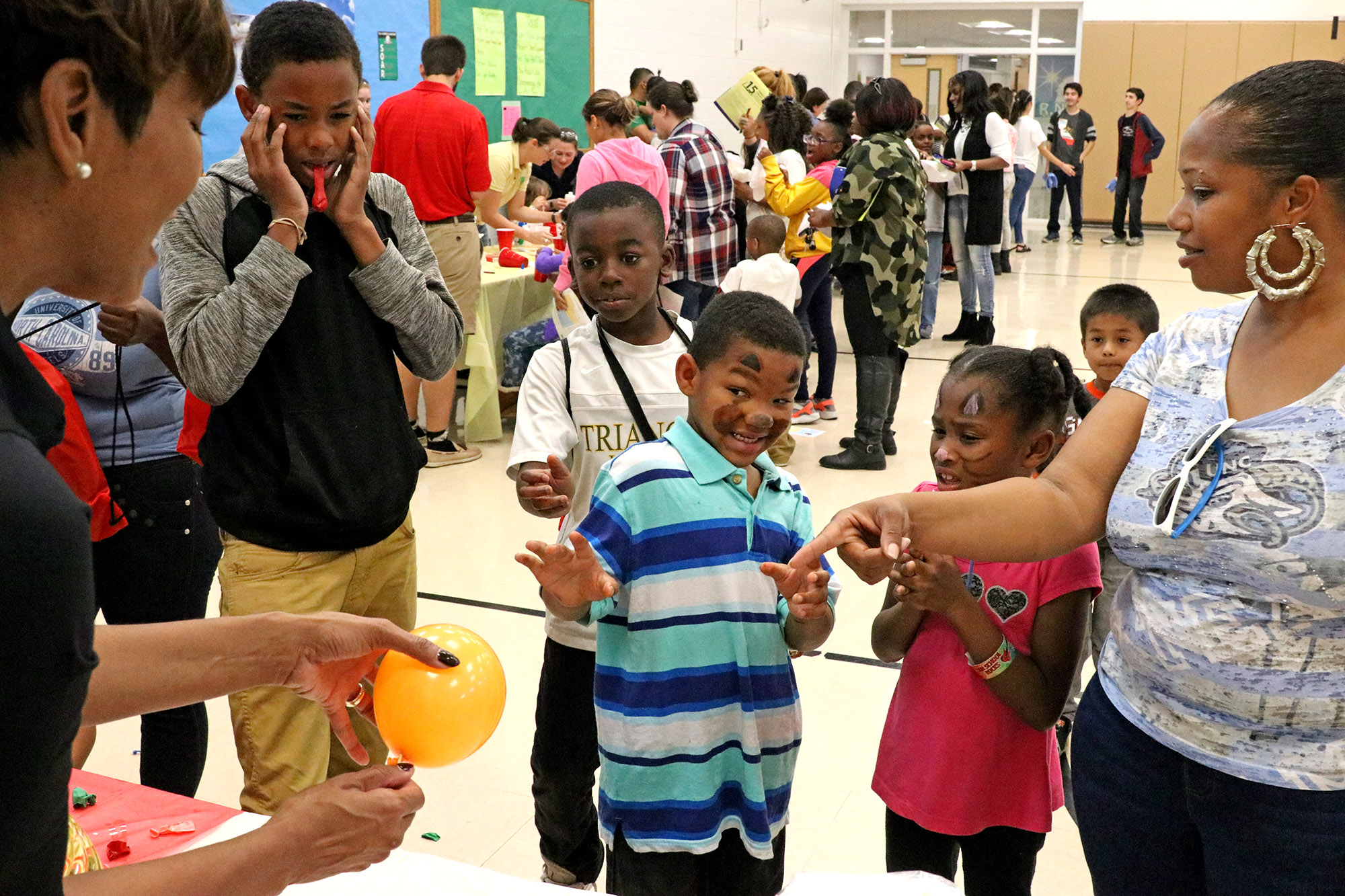
Demarcus Lynn (Lucas Middle School), Malachi Cates (Eastway Elementary), Tay’sean Elliott (Eastway), Kamiah Elliott (C C Spaulding) and Penny Elliott watch a demonstration performed by Tomesah Harrison, VP of Human Resources at Bayer Corporation. (Staff photo by Nile Foxx)
The gym at R N Harris Elementary was bustling with activity on a recent Saturday afternoon. Hundreds of families came to participate in the STEM + Families: Community Family Fall Festival.
The event on Oct. 28 was a partnership of Durham Council of PTAs and Bayer Corporation, and was made possible through a National PTA initiative grant.
According to the National PTA website, the goal of the initiative is “to increase access to STEM education and careers, especially among under-represented youth, by developing, evaluating and sharing effective ways to engage families in STEM experiences, while working with partners to improve access to STEM school and community learning environments.”
Students got their hands dirty working on various experiments, including ice cream chemistry, candy chromatography, Martian jelly, spooky slime, DNA extraction and balloon skewers.
“The activities are designed to be very hands-on,” said Casey Allen, communications manager at Bayer. “The students can do the measuring and mixing and then see a result and understand that there is a science principle behind it.”
Students were seen all over the gym grinning as they actively participated in the science demonstrations.
“My favorite was when I did the one with making the ice cream with the ice and the salt and the milk,” said Izabella Mobley, a 7 year old from Holt Elementary. “My favorite thing about science is to experiment with stuff that I’ve never done before.”
The excitement of the event wasn’t limited to students. Durham Board of Education member Natalie Beyer stressed the importance of these opportunities.
“Isn’t it amazing to see such engaged, hands on learning on a Saturday in an elementary school?” said Beyer. “To see families together, and to see community volunteers — it is exactly what education should be.”
Bayer Corporation is interested in the future of the STEM career field as a result of the poor national performance in science and math. The 2015 Programme for International Student Assessment put the United States at 38th in math and 24th in science out of 71 countries.
“In the United States, there has been a lag behind in STEM education,” said Allen. “We are trying to get young people excited and encouraged to try science and be curious about science. And that is what this is all about.”
In addition to an overall lag in STEM success in the United States, there is an achievement gap that affects minority communities. NSF statistics show that over 73 percent of scientists and engineers are white, while just 11 percent of the STEM workforce is African American or Hispanic.
“We understand that there is a gap,” said Allen. “There is an underserved community, particularly with minorities. So there is a need for more diversity in the STEM fields.”
Another major focus of the event is to get parents involved in their students’ education. A
2002 report from Southwest Educational Development Laboratory showed that “regardless of family income or background, students with involved parents are more likely to: Earn higher grades and test scores, and enroll in higher-level programs, be promoted, pass their classes, and earn credits and attend school regularly.”
“Parent involvement is definitely an indicator of academic success,” said Danielle Bonner, the president of The Durham Council of PTAs. “If we can empower parents that feel stigmatized by PTA or even the educational system, we have set a lot of different kids up for a much better outcome.”
Parents were encouraged to spend time interacting with their children and participating in the experiments.
“They get to have fun and they learn stuff,” said Penny Elliot, a parent of three Durham elementary students. “They need to have more events like this.”
The lack of minority representation in many STEM fields discourages underrepresented groups from picturing themselves in a STEM career in the future.
“We have had older kids on field trips to RTP — to corporate entities out there and have heard some students say, ‘Do you think they hire custodians here?’” said Beyer.
“So we want children to know that every occupation, every career path, every dream of inquiry is open to them from the earliest ages.”